NEC PX-42XR4A 42" Plasma HDTV Review
Chris Iannicello
June 20, 2006
HDTV Solutions
Released in September 2005, the PX-42XR4A, also know as the 42XR4, is NEC's second generation 42" Home/Showcase display, replacing the PX-42XR3. NEC also offers a Professional line of plasmas geared for industrial use that share the same "glass" as the Home/Showcase line, but have slightly different features and lower retail prices.
Some of the key features of the PX-42XR4A include:

Redesigned appearance

Increased input connectivity

68.7 billion colors - 12-bit
gamma processing

100% and 130% brightness & contrast increase compared to predecessor

60,000 hour half life

Enhanced picture in picture

$3999 MSRP, approx. $2600 street price
Walkaround
The PX-42XR4A was shipped directly from the manufacturer along with a heavy duty PX-ST2U swivel table stand (about $300 retail), which allows 10 degrees of rotation left or right. NEC also includes a service manual, installation guide, remote control, and power cord. Attaching the display to the stand was relatively easy, but you may need an extra pair of hands to get the job done. The end result, however, was the sturdiest display I have reviewed to date.
The design of the display is elegant, with a large black bezel surrounded by a small silver border with an all silver stand. There are no speakers, but there were inputs to add them if desired. The total depth mounted is approximately 3.9 inches, which is a tad thicker than most 42" displays, but still very svelte.
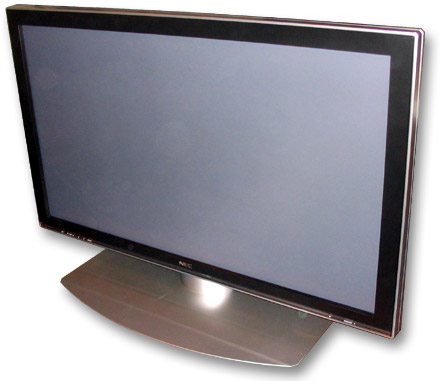 |
| NEC PX-42XR4A 42" Plasma HDTV |
NEC PX-42XR4A 42" Plasma HDTV
One unfortunate result of the bezel design is that light from the display gets reflected off the bezel and pointed back towards the viewer. The end result is that with brighter portions of a scene, there appears to be a mirrored 'border' around the image, which I found mildly distracting on occasion.
 |
The Masters
Bezel Light
NEC PX-42XR4A 42" |
Under the Hood
The PX-42XR4A has a resolution of 1024x768, which is standard for most 42" plasma displays. NEC does not post contrast ratio information on this display, but as I have mentioned in other reviews, the actual rated contrast in real-world conditions will be much lower anyway so not much attention should be paid to this measurement. The claimed display half-life rating (the amount of time it will take for a display to dim to 50% of its original brightness) is the current industry standard of 60,000 hours.
Other features include 12-bit video processing called Gamma 12, producing 4096 shades of gray steps for each "cell," which results in 68.7 billion colors. Gamma 12 color processing was used in the previous NEC plasma generation, but many current plasma displays still use 10-bit processing and 2048 (or less) shades of gray, so NEC's specs in this area should still be considered 'industry-leading'.
The PX-42XR4A has independent input memory settings, so viewers can calibrate their displays using different settings for each video source. This is an important feature because, as you will see below, different video sources can produce drastically different images even on the same display.
The PX-42XR4A includes two HDMI inputs, two component video inputs, an S-Video and composite input, and a VGA input. There are also 3 sets of audio inputs that can be programmed to link to any of the video inputs, which is a nice feature in case you want to use both HDMI inputs for different video sources that require dedicated audio inputs.
 |
Connector Panel
NEC PX-42XR4A 42" |
 |
Remote Control
NEC PX-42XR4A 42" |
Behind the Wheel
The remote is well-designed and laid out with just enough buttons to cover the important functions of the display. The system menus were easy to find and navigate using the remote, and a dedicated button for each input is always a welcome design feature. Also, the remote has a large circular arrow button, which is much easier to use compared to individual up/down/left/right buttons found on many remotes.
Navigation through the basic system menus was relatively easy; however there were some submenu titles within the basic menus that blended in a bit much as they had no label or markings next to them. For example, I didn't realize the Color Tune setting within the Picture settings had a complete submenu with additional settings as there were no markings or text next to it (see the Picture menu below). With most displays I've used or reviewed, there is usually a right-arrow or some type of marking indicating there is more information if you select the item. The system menus actually have a commercial look and feel to them, which is a compliment as I find that commercial models are usually much easier to use and navigate.
Main Menu - Press the 'Menu/Enter' button on the remote and the following menu will appear:
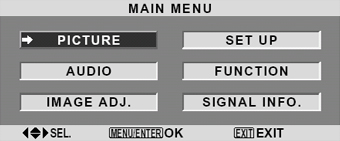 |
Main Menu
NEC PX-42XR4A 42" |
Picture Menu - The Picture Menu is where almost all video calibration is performed. As you can see, it is laid out in a simple fashion, with slide bars for the most common video settings. There is a noise reduction feature, and several other image adjustment controls. The Cinema Mode setting automatically detects the video source and sets the display to the most appropriate resolution and aspect ratio (ex. 480i vs. 1080i).
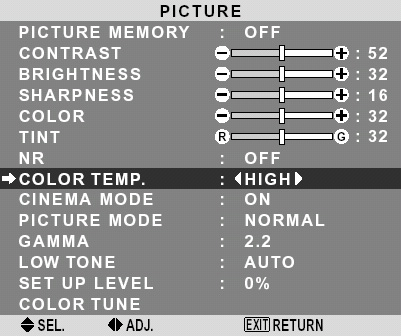 |
Picture Menu
NEC PX-42XR4A 42" |
One notable feature that you won't find in most consumer plasma displays is the aforementioned Color Tune settings, which allows you to manipulate six individual colors to fine-tune color accuracy and saturation. Even though I found I didn't have to make a great deal of color-related adjustments, this is a great feature for those who make the effort of properly calibrating their display. Also, notice how for each color setting the slide bar indicates which color you are accentuating. For example, when you adjust the Red slide bar to the right, you know that reds will start to show more magenta. This is a very nice touch for those of us who are a little rusty with the color spectrum.
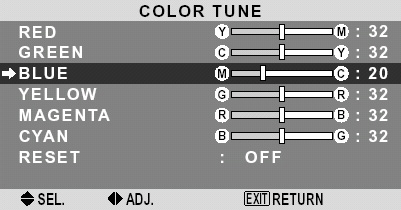 |
Color Menu
NEC PX-42XR4A 42" |
Setup Menu - The Setup Menu contains settings for language, inputs, and menu location. The Gray Level setting determines how dark the unused portions of the display are during 4:3 or letterbox viewing.
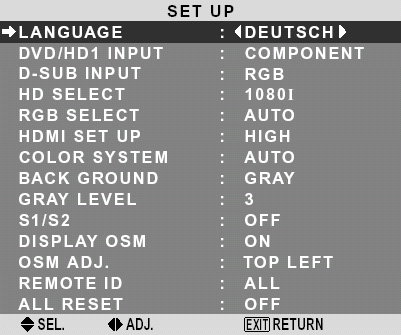 |
Setup Menu
NEC PX-42XR4A 42" |
Audio Menu - The Audio Menu is useful primarily for setting the multiple audio inputs to the correct video inputs being used. Very rarely will you have to make any substantial adjustment to bass and treble when hooking up small speakers directly to the display.
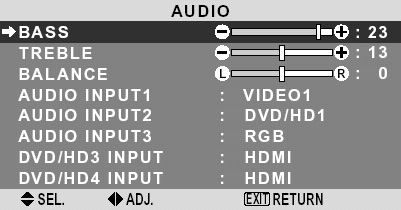 |
Audio Menu
NEC PX-42XR4A 42" |
Function Menu - The most notable controls of the Function Menu are Input Skip (so you don't have to flip through all the inputs not being used) and the Closed Caption menu. The PDP Saver feature contains several anti-retention image settings such as orbiter and soft-focus, which should help prevent screen burn-in. These types of preventative features are common in most newer plasma displays.
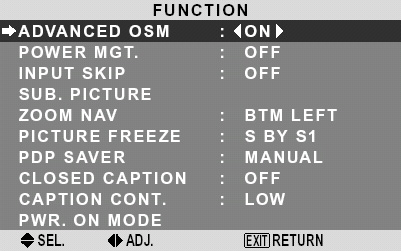 |
Function Menu
NEC PX-42XR4A 42" |
Image Adjustment Menu - Here you can modify the size and position of the image in case there are any major overscan or position issues. You can also use the Fine Picture and Picture Adjustment controls in the rare case you experience any vertical banding or flickering.
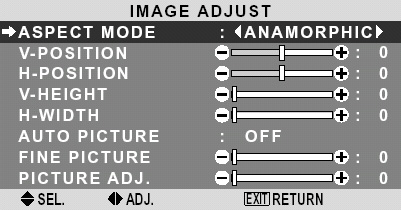 |
Image Adjust Menu
NEC PX-42XR4A 42" |
Test Drive
I connected the PX-42XR4A to the Scientific Atlanta 8300HD Cable box via the HDMI input. I sampled several types of high definition content including movies, sports, and regular television programming, all of which looked very impressive. The first thing I noticed was the fantastic black levels while retaining mid-tone smoothness throughout the contrast range. There was, however, a significant amount of signal noise and I had to back up to 9 feet for it not to be distracting, which is 1-2 feet further back than many leading 42" plasma displays.
Here are a few sample images of the PX-42XR4A, compared to the Pioneer PDP-505CMX 50" Plasma Display (The PX-42XR4A is the bottom image in each of the frames). The Pioneer was impressive in its own right, but the NEC outperforms the Pioneer in several key areas.
2006 Winter Olympics (NBC HD, 1080i)
While the Pioneer appears to have a more vibrant, saturated image in this shot, it is due to the fact that its color displays a substantial orange or warm cast, which accentuates the red and orange subject matter. The NEC color accuracy across the board is closer to neutral with good flesh tones. Resolution with both displays is excellent.
 |
2006 Winter Olympics
TOP: Pioneer PDP-505CMX BOTTOM: NEC PX-42XR4A |
2006 Grammy Awards (CBS HD - 1080i)
The Pioneer may be a bit punchier, but the NEC has smoother transitions from dark to light resulting in a more natural image. With the NEC, you see a bit more facial detail compared to the Pioneer, which has brighter highlights at the expense of some mid-tone contrast.
 |
2006 Grammy Awards
TOP: Pioneer PDP-505CMX BOTTOM: NEC PX-42XR4A |
I, Robot (HBO HD - 1080i)
Besides the color accuracy issue with the Pioneer, these two images are comparable, with excellent black levels. The NEC might be a touch on the cool side, but both images are well saturated with rich colors across the entire frame.
 |
I, Robot
TOP: Pioneer PDP-505CMX BOTTOM: NEC PX-42XR4A |
Sin City (HBO HD - 1080i)
In this black and white scene, the NEC is close to the benchmark 6500K
color temperature, with a very slight blue or cool cast. The color accuracy of the NEC further illustrates the substantial green-cast of the Pioneer.
 |
Sin City
TOP: Pioneer PDP-505CMX BOTTOM: NEC PX-42XR4A |
The Fifth Element (Oppo OPDV971H DVD Player - 720p via DVI to HDMI)
While the NEC displays a smooth, lifelike image with HDTV signals relative to the Pioneer, the opposite is true with DVD signals. Part of the reason is because the Pioneer has industry-leading image processing which results in superb DVD performance, but even on its own the NEC's DVD performance is just average. In this image, the resolution of the NEC is very good, but shadow detail and color saturation are mediocre. The flesh tones are bordering on purple and I had to do quite a bit of tweaking to see any improvement.
 |
The Fifth Element
TOP: Pioneer PDP-505CMX BOTTOM: NEC PX-42XR4A |
Perhaps an explanation for the color issues of the comparison above is that I did not use the factory default settings. I changed the HDMI Set Up setting from the Set Up Menu from High to Low. As you can see below, the top image (HDMI Set Up - High) has more color saturation and better color accuracy, but has excessive contrast and very poor shadow detail. While the bottom image (HDMI Set Up - Low) takes a hit in color accuracy and saturation, I feel the overall relative smoothness and shadow detail more than make up for it. The Operations Manual actually suggests using the High setting for DVD sources. Component video performance was similar to the bottom image as well.
 |
The Fifth Element
TOP: HDMI Set Up - 'High' BOTTOM: HDMI Set Up - 'Low' |
Color
As you can see from the sample photographs, the color accuracy of the PX-42XR4A is quite good, with some very slight blue-cast that was easily remedied by adding a few clicks to the Red individual color setting. Some viewers might want to also change the color temperature setting from the factory default Middle to Middle Low as even the PX-42XR4A user manual describes the Middle setting as Standard (slightly bluer). I would assume NEC's rationale is that most viewers prefer a slight blue-cast compared to a red-cast as a blue-cast image gives off a slightly fresher look compared to a red-cast image. The color saturation was first-rate with rich, deep colors and life-like flesh tones, especially after adding some red to the factory default color settings.
Contrast/Black Level
This is perhaps the most surprising aspect of reviewing this display, as previous NEC models have been average in this area. With HDTV sources, the black levels, shadow detail, and smoothness of contrast were one of the best features of the PX-42XR4A. However, DVD and non HD sources (digital cable, analog cable, etc) were only average, and while you'd expect to see reduced quality and resolution compared to HD sources, you normally would not experience the significant drop off in color accuracy and contrast that was observed with the PX-42XR4A.
Brightness
I never noticed any issues with the brightness of the PX-42XR4A, as it provided plenty of punch regardless of how much ambient light was present. There is still a significant amount of reflection from the display's surface, but no more than any other plasma display.
Video Processing
NEC touts several features such as Enhanced Motion Adaptive 3D Scan Conversion and Enhanced Mass Area Superior Sampling that are designed to improve moving video and reduce jaggies. During testing, I found the scaling conversion performance of the PX-42XR4A to be adequate, but certainly not industry-leading. In one particular scene from the digital cable broadcast of the movie Assassins, the camera shows a shingled building and does a slow pan upward, which produced a substantial amount of motion artifacts or jaggies compared to the Pioneer PDP-505CMX, which is known for their superb video processing. That being said, during normal viewing I never was distracted by excessive motion errors, jaggies, or any other scaling artifacts.
The stretch mode (titled Stadium mode) of the PX-42XR4A when viewing 4:3 material worked well, but I did notice some vertical overscan when the image is stretched. There are several aspect modes such as anamorphic, 2.35:1, zoom, and 14:9. Each setting has specific uses for various types of non-HD source material.
Viewing Angle
NEC claims a viewing angle of 160 degrees (horizontal and vertical) on their website, which is the current industry standard. I found the PX-42XR4A to maintain image integrity at all but the most severe angles, vertical or horizontal.
Viewing Distance
As mentioned, signal noise is the biggest flaw of the PX-42XR4A, which means that many viewers will find themselves backing up a bit to not be distracted by the noise. I found 9 feet to be the sweet spot, which is about 1-2 feet away from where I have seen EDTV plasmas look really good. In other words, the NEC takes me about as far back as I would go with an HDTV plasma before considering it a deal breaker when you take into account that some top notch EDTV plasmas are selling for $1500 or less, over $1000 cheaper than the NEC.
Picture-in-Picture
This is one of the features that is touted by NEC in that not only does the PX-42XR4A provide standard PIP options such as basic "big and small" and "side-by-side" modes, but they also offer transparent PIP, where you can control the transparency of the smaller PIP image in 10% increments. In addition, you can program the display to only show the PIP window when a signal is detected for that input.
PC Monitor
In addition to the VGA PC input, the PX-42XR4A's HDMI input can accept PC signals at multiple resolutions, but I achieved the best results setting my computer's resolution to 1280 x 720 and the plasma display to Anamorphic. The results were mediocre at best, as detail was quite choppy and brightness was not very bright at all, especially with lighter colors. I don't necessarily fault NEC, however, as I have yet to see any plasma display handle PC signals very well, especially compared to comparable LCD displays.
As with the Pioneer PDP-505CMX, there was a significant issue with lack of brightness that worsened as more white was present on the desktop. I was unable to fix this issue with any of the brightness or energy saving settings. The issue was also present when using the RGB input. Because of this, the PC image was barely acceptable with colors or darker images, but unacceptable with any image that was primarily grayish or primarily white, such as most web pages, emails, etc.
In the frame below, the left image has a window maximized the width of the display (although that portion is cropped from this picture), displaying a great deal of white. The right image is only opened as wide as the text in the photo (the desktop background color for the photo on the right is dark blue), which is about half the width of the display. Because of the increased amount of white spread across the display, the left image is clearly darker than the right image.
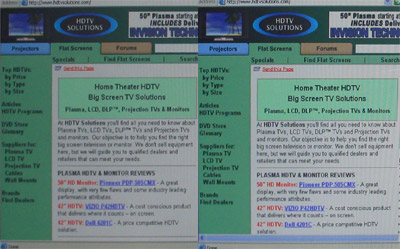 |
HDTVSolutions.com
LEFT: Window Fully Open RIGHT: Window Half Open |
Ratings
Performance: 4 out of 5
While contrast, shadow detail, and color performance were excellent with HD sources, there was significant signal noise which will require most viewers to move away from the display a foot or two more than comparable industry-leading 42" plasma HDTV displays. Also, relative non-HD source performance was not as impressive with shadow detail and color accuracy being the primary culprits.
Features: 4.5 out of 5
The PX-42XR4A has some great features, such as cutting-edge picture-in-picture, dedicated color adjustments, and independent memory locations for each input. Two HDMI inputs are becoming almost essential, and the ability to program audio inputs to various video inputs is a nice touch. The PX-42XR4A does not have a built-in tuner, but most viewers will go with a cable/satellite solution anyway. The only thing I would recommend is to include built-in speakers as the PX-XR4A is positioned as a consumer or home display.
Ease of Use: 4.5 out of 5
Overall, I found the PX-42XR4A easy to operate and configure. The documentation was well written and the menus were laid out in a intuitive fashion, although there were some submenus I found easy to overlook. The remote was easy to use and understand, with dedicated input buttons being its best feature.
Value: 3 out of 5
With a MSRP of $3999 and current street prices of about $2600, the NEC is behind the curve compared to its competitors, some of which are now selling for under $2000. While the NEC outperforms most of it's competition, some of these low-priced displays are equal if not better than the NEC in overall features and performance.
Conclusion
The PX-42XR4A is a huge step up from NEC's previous offering, making substantial improvements in overall contrast and shadow detail performance. Color accuracy and saturation are excellent, requiring very little adjustments out of the box for HD sources. It still has some issues, such as signal noise, bezel design, and price, but the PX-42XR4A is still a very solid offering and should be considered along with other top tier 42" plasma displays, especially if you can find a good deal on one.





 Redesigned appearance
Redesigned appearance Increased input connectivity
Increased input connectivity 68.7 billion colors - 12-bit gamma processing
68.7 billion colors - 12-bit gamma processing 100% and 130% brightness & contrast increase compared to predecessor
100% and 130% brightness & contrast increase compared to predecessor 60,000 hour half life
60,000 hour half life Enhanced picture in picture
Enhanced picture in picture $3999 MSRP, approx. $2600 street price
$3999 MSRP, approx. $2600 street price![]() del.icio.us
del.icio.us
![]() Reddit
Reddit
![]() Google
Google























